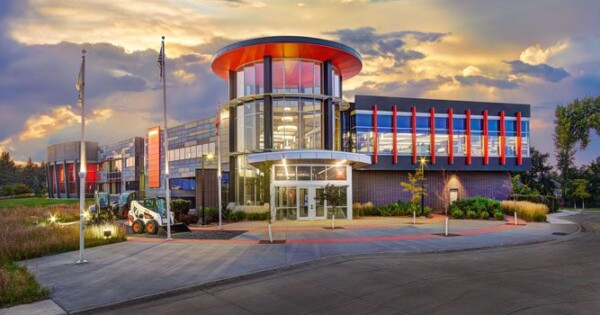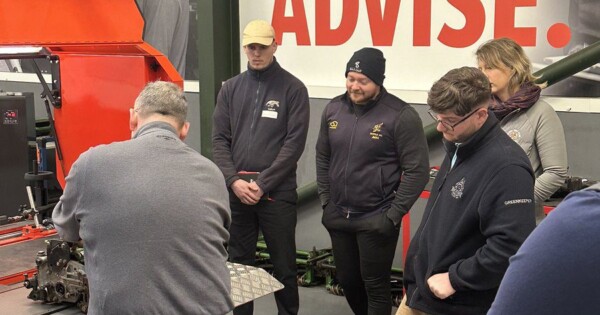‘Grass Roots’ Initiative delivers message for turf
‘Grass Roots’ Initiative delivers message for turf
The following has been published in Turf Producers International – Turf News by Suz Trusty – Co Editor
The ‘Grass Roots’ Initiative, a collaboration of the U.S. National Arboretum (operated by the USDA’s Agricultural Research Service) and the National Turfgrass Federation (NTF), fills a vital role in delivering the message of “…the uses of turf, the management of turf, the benefits of turf, the value of turf.”
Its centerpiece, an innovative exhibit of interactive displays located near the Arboretum’s visitor center, has been capturing the attention of an ever-increasing number of Washington, D.C. visitors since it opened in the fall of 2014.
The Lawn Institute is one of the sponsors of ‘Grass Roots’. Kevin Morris, NTF president, and executive director of the National Turfgrass Evaluation Program (NTEP), says, “ Sod producers, locally and regionally, were instrumental in donating products and services to launch the ‘Grass Roots’ exhibit.”
Exciting outreach is radiating from that sold base reports Geoffrey Rinehart, Grass Roots Initiative coordinator, providing an update on the highlights.

‘Grass Roots’ Growing to Maryland SoccerPlex
The USDA/NTF ‘Grass Roots’ initiative and the Maryland SoccerPlex have partnered to create ten interactive educational displays at the complex in the same format as those featured in the arboretum exhibit.
The Maryland SoccerPlex, about 25 miles northwest of Washington, D.C., in Boyds, MD, features 24 regulation sized soccer fields and an award-winning stadium field. It’s the home of multiple programs of the Soccer Association of Montgomery (SAM) and of professional level play with Washington Spirit of the National Women’s Soccer League. In addition, it hosts regional and national youth soccer tournaments, drawing over 600,000 visitors per year. The ‘Grass Roots’ exhibit is strategically located to attract those visitors, on a one acre site in front of the ticket booth on the south lawn adjacent to the SoccerPlex’s stadium field.
Read Also: Maryland SoccerPlex and Grass Roots Partner on New Interactive Outdoor Exhibit
“We are very excited to partner with ‘Grass Roots’ and to have such an interactive and educational exhibit at the Maryland SoccerPlaex,” said Maryland SoccerPlex Executive Director Trish Heffelfinger. “The exhibit will highlight new technologies in the turfgrass industry, and the effects of turfgrass and lawns on the environment. It will also, hopefully, lead to further scientific breakthroughs.”
[Tweet “The exhibit will highlight new technologies in the turfgrass industry, and the effects of turfgrass and lawns on the environment.”]
The enthusiasm is shared. “Collaborating with the Maryland SoccerPlex made sense on so many levels,” said Morris. Right from the beginning Trish (Heffelfinger) offered to not only help with funding, but offered the expertise of the SoccerPlex Director of Grounds Ryan Bjorn and his crew.” Rinehart adds that the assistance will extend far beyond the initial development, with Bjorn and his crew providing the onsite maintenance for the exhibits. “It’s already a great partnership,” says Rinehart. “We’re all looking forward to the open communications and ability to share the similarities and difference between the sites, both on the technical components of turfgrass management and the visitors’ interaction with the exhibits.”
Construction began in March, with the grand opening of the completed exhibit scheduled for early September. Naturally, the first area of concentration was the sports field segment. Rinehart says, “We put in the irrigation and the four sports fields are in place, each featuring a different surface. The cool-season field is turfed with HGT Bluegrass. One of the warm-season fields is Latitude 36 Bermudagrass; the other is Zeon Zoysiagrass. The last filed is synthetic turf. Chad Price, president of TPI member Carolina Green Corp., Indian Trail, NC, handled the sports field installations. The company also was a major contributor of the sod and services for the ‘Grass Roots’ displays at the arboretum.”
The ‘Grass Roots’ exhibit drew and estimated 30,000 visitors during our first calendar year. That’s nearly seven percent of the 400,000 visitors to the arboretum. Attracting seven percent of the Maryland SoccerPlex’s 600,000 visitors would total 42,000. With the format of tournament play, a team might play its first game at 8:30 am and then play again around 11 am. Families are at the complex and will be looking for something interesting to do between games – like visit the ‘Grass Roots’ exhibit. We’re anticipating that factor will raise the attendance percentage significantly. And the number of visitors to our Arboretum display continues to grow. Between two locations, we could have 80 to 90,000 people learning about the benefits of turfgrass. – Geoffrey Rinehart ‘Grass Roots’ Program Coordinator
The National Cherry Blossom Festival “Petal” to the Parks Bike Ride
Rinehart says, “This is the second year ‘Grass Roots’ has partnered with the Cherry Blossom Festival on a bike ride. They want to broaden their reach to all potential visitors. By working with them and connecting with their public relations and marketing expertise, we an introduce a wider audience to the benefits of turfgrass.”
Most people don’t realize that all of the city parks in Washington, D.C. are run by the National Parks Service (NPS). To tie into the centennial year for NPS, the Cherry Blossom Festival selected “Connecting People to Parks” as their theme and several parks we visited by the nearly 40 riders that gathered on May 15. Park Rangers met the group at each park site, talking turf and answering questions. The Bike Ride is made possible through partnerships with BicycleSPACE, NPS, the National Arboretum and NTF. Participants, including Kevin Morris, gathered in the DuPont Circle area of DC to begin the 13-mile ride. They rode through Georgetown; stopped at Rock Creek Park; then pedaled to “America’s front yard,” the National Mall. During that stop, the riders learned a bit about the historic landscape and details of the Mall renovation. With the sustainable subsurface work completed, the last green component was added by the installation of approximately a half a million square feet of sod, supplied by New Jersey based Tuckahoe Turf Farms, Inc.
Then the bikers wound through Anacostia Park, a multi-attraction facility that borders the Anacostia River. The ‘Grass Roots’ exhibit was their last stop where Rinehart greeted them with snacks and drinks. He encouraged them to join in a scavenger hunt for the Cherry Blossom Festival’s mascot, Petals, a charming gnome. Of course he and Morris shared information on the displays with the riders, inviting them to interact with the turf as they learned about it.
As Rinehart notes, such events contribute to the bigger picture, the continuing efforts to work with the NPS on developing the National Greenscapes Corridor concept. It’s a collaborative effort among the U.S. National Arboretum, the National Mall, and Arlington National Cemetery, all top stops for national and international tourists. “The NGC seeks to promote public awareness of the use of turfgrass and turf’s role in these iconic places, how turfgradd contributes to the functional, cultural and historical significance of these places, and how the inputs used to maintain these areas produce many benefits for society.”
National Golf Day – National Turfgrass Federation Day on the Hill
May 18, 2016, was the ninth year for National Golf Day. It is now coordinated by WE ARE GOLF, which was created in 2010. Described on its website as, “…an industry coalition that communicated the economic, charitable and environmental impact of golf, as well as the health and wellness benefits of the game and the affordability and accessibility of golf, the Members of Congress, the Executive Branch and regulatory agencies. The goal of WE ARE GOLF is to ensure that laws and regulations that impact the golf industry are equitable and appropriate to an industry that generates nearly $70 billion in economic impact annually, impacts close to two million jobs and generates nearly $4 billion in charitable giving each year.” Steve Mona, CEO of World Golf Federation, is also administrator of WE ARE GOLF.
[Tweet “WE ARE GOLF to ensure that laws and regulations that impact the golf industry are equitable and appropriate @stevemona1“]
Among the golf organizations that participated in the event are: the Club Managers Association of America, Golf Course Superintendents Association of America, Ladies Professional Golf Association, National Golf Course Owners Association, PGA of America, PGA TOUR, United State Golf Association, and United States Golf Manufacturers Council. The organizers announced the year’s event also included PGA TOUR Commissioner Tim Finchem, 2016 U.S. Rider Cup Captain Davis Love III, Vice Captain Steve Stricker and LPGA legend Nancy Lopez.
The post-event press release reported National Golf Day 2016 was the most successful to date, with over 150 scheduled Congressional meetings in one day.
Morris reports May 17, 2016, was National Turfgrass Federation Day on the Hill. With the long-term, synergetic relationships forged over the years, working in tandem to reach the same audience is not just logical – it’s smart. Thus ‘Grass Roots’, the most visible and recognizable connection to NTF for governmental personnel, was one of those participating int he day-long exhibit in the Rayburn Foyer of the Capitol Building. Rinehart says, “The ‘Grass Roots’ exhibit focused on turfgrass education and outreach and the importance of professional turfgrass management to golf courses, the environment and the economy.”
Morris adds, “Mark Weekly from Chantilly Turf Farms, Inc., Chantilly VA; and Professor and Extension Turfgrass Specialist Dr. Mike Goatley, of Virginia Tech, Blacksburg, VA; did a great job of representing TPI during the National Golf Day/National Turfgrass Federation Day on the Hill. Our focus is discussing turfgrass benefits with Congress and the Administration, as well as discussing strategies to increase funding for turfgrass research within the federal government.”

A big highlight for Rinehart was the turnout for a pre-arranged tour of the ‘Grass Roots’ exhibit. He says, “Despite rain and 57 degree temperatures, 18 of the 22 who had signed up attended, and two more showed up for an even 20. The interaction was excellent. And several of those who were not able to take part expressed their regrets and commented that they’d heard the tour was great. I was really encouraged by the positive feedback.”
And More Outreach
The major projects and events already noted are making a strong impact in multiple areas – and there are multiple other outreach activities underway. Rinehart conducts Homeowner Workshops on three weekends in the spring and two in the fall. They cover topics such as correct species for the site, seed or sod selection, water saving strategies, mowing heights, fertilization and spreader calibration, and basic turfgrass cultural practices, including aeration and detaching. “Attendance ranges from 10 to 25,” he says. “The goal is 30 to 40 for each workshop.”
He also provided turfgrass training for Master Gardener programs in Fairfax and Montgomery Counties. “Classroom sessions are scheduled for the winter months, with follow-up training at the ‘Grass Roots” exhibit in the spring,” he says.
Rinehart is cultivating relationships with governmental agencies, too. He has given tours and interacted with personnel from the EPA Water Sense program. He’s offered tours and technical support with turfgrass related programs to other agencies and departments.
All this, and the ongoing maintenance of the exhibit area, management of the website and social media, and all those other things on the “To-Do” list require time, effort – and funding. Support in any and all of these big three would be much appreciated.


